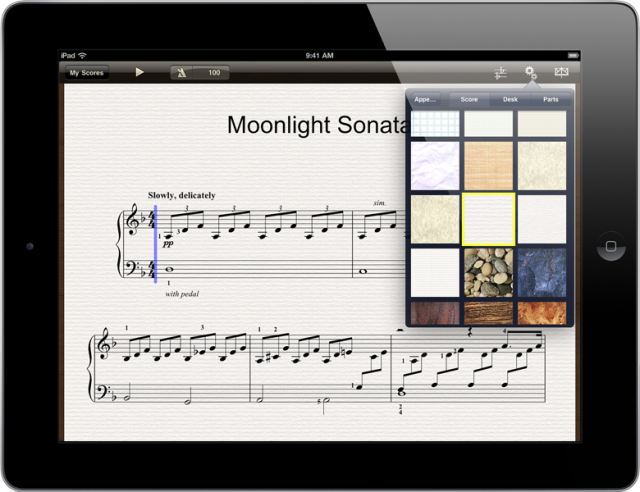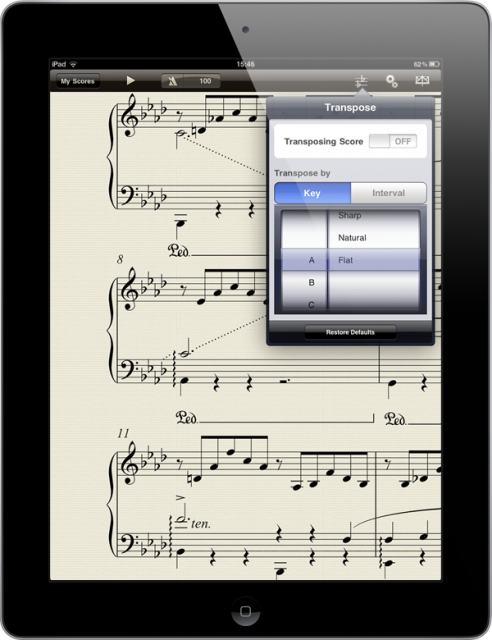Let’s get this out of the way first: if you’re looking for a tool for composing and editing scores on your iPad, Avid Scorch isn’t it — not yet, at least. But as a score reader, Scorch could be a glimpse of a future in which tablets create a new marketplace and exchange for notated music.
Scorch is, first and foremost, a score reader. It shares the mature notational display engine of Sibelius, and makes use of Sibelius’ (and now Pro Tools’) scores. That includes Sibelius’ broad library of musical symbols, guitar tab features, and handwritten fonts, among other features. (It even includes the somewhat silly, but potentially-comforting, textures that have long been a feature of the desktop product.)
The role of tablets in digital music is still evolving. But it’s not hard to make a case for the form factor here: unlike a MacBook Pro or a PC tower, you can put a tablet on a music stand. As such, a tiny device can have dynamic access to a near-limitless collection of music. We’ve already seen impressive takes on the classic jazz fake book on the iPad, and they handily beat the older form when it comes to weight or bulk.
That leaves the question of what reading a score on what remains essentially a computer, in place of on paper, actually means. Scorch shows off some advantages here. For instance, you can transpose scores – say, for a singer, or a different reed instrument – in realtime. (That grumbling noise you hear is people complaining about the loss of musicianship and the ability to sight-transpose. I agree, to a point – but I’ve also known some musicians who could do that who also used the transposition button on a digital piano.)
Other features could broaden the appeal of notation in general. With one tap, you can convert a line to guitar tab, dynamically, as seen in the image below. You can change fonts, or pull out a single part, in order to improve readability. These are things that would normally require a copyist to go back to the drawing board and make new parts, even in the computer age. The very notion of what a score is is changing: that score becomes dynamic, electronic, and live, open to instantaneous shared revisions.
I’m following up with Avid’s developers and testing the application myself, as some questions remain. Turning pages electronically could theoretically be easier … or not. There’s an interactive “Music Stand” mode, but that’ll require an actual test. (Stay tuned for results of that shortly.) Depending on your instrument, you may not have a hand free, and on the iPad, there’s no way to tape multiple pages together to increase the size of the paper. My bet is that we’ll badly need a footswitch. (See this week’s discussion of augmenting tablets with foot pedals.)
While I investigate that, though, it’s just as interesting to ponder that Scorch is not just an application, but a marketplace. Using Apple’s in-app payments (the rules for which this week were loosened), you can purchase scores or download free scores. The display even looks like e-reader apps from Apple, Amazon, and others. With brick-and-mortar music stores few and far between, and the record store long gone, this is huge news. Demand for notation has been on the uptick, as popular music, reality TV, and shows like Glee continue to feed on – and feed – appetite for musical expression. (I need to pull some solid numbers on that, but I do know there are some positive signs; that’s probably a topic for another story.)
Scorch could be the start of something big – and with electronics makers around the world, not just Apple, betting on the tablet, it could be a sign of other tools to come.
I still imagine many people want to use tablets to make scores, not just consume them, and I expect that to be a growth area, too. But Scorch is notable as the first big-league entry into what could be a transformative arena. And it could be transformative in ways that are more profound than even digital distribution of music. Notation has evolved the way it has on a paper medium, designed to be fixed, still influenced by the conventions of the pen and engraving. The next question: will scores, from creation to display, need to change, too?


